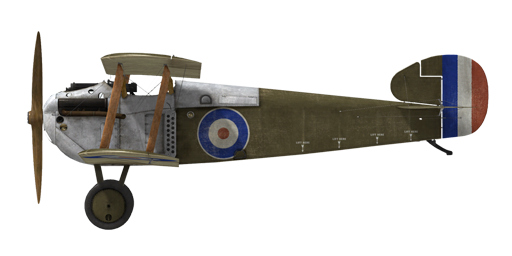il2
Sopwith Dolphin

Description
The Sopwith Dolphin was designed by the Sopwith Aviation Company in Britain. In designing the aircraft, the flaws of the Sopwith Camel were taken into account. These included bad forward and upward visibility and difficulties of handling a rotary-powered plane. In response to the latter issue, the engineers elected to fit the new aircraft with an inline engine. The design featured a compact arrangement of the cockpit, fuel tanks, machine guns and engine. This resulted in the pilot’s head being level with the hatch on the upper wing. The radiators were moved to the sides of the fuselage and behind the cockpit. The first trial flights were made in May 1917. In addition to the Sopwith Aviation Company, several other companies manufactured the aircraft: Darracq, Hooper, and SACA. By the end of the war, 1532 planes of the type had been built.
Operational evaluation of the Dolphin began with the British No. 56 Squadron on June 13, 1917. Several design improvements would follow. In January 1918, No. 19 Squadron became the first operational unit to receive production examples of the Dolphin. The type was employed against enemy fighters and balloons, especially at high altitudes, where it was superior to the Sopwith Camel. It was also used to bomb and strafe ground targets.
Dolphin pilots noted the plane’s good balance of controls, perfect visibility upward and forward, but the downward visibility was obscured by the lower wings and the engine cowling. The plane was a formidable opponent, as it possessed the manoeuvrability of the Sopwith Camel and a speed and climb rate equal to that of the S.E.5a. Pilots often complained about the cockpit crumpling and its tendency to nose over on harsh landings. For a short period, French and American pilots flew these aircraft. It took part in battles over the Western Front.
Engine
V8 Hispano—Suiza 8Ba 200 hp
Dimensions
Height: 2600 mm
Length: 6700 mm
Wing span: 10000 mm
Wing surface: 24,5 sq.m
Weight
Empty: 660 kg
Takeoff: 893 kg
Fuel capacity: 123 l
Oil capacity: 18 l
Maximum airspeed
sea level — 203 km/h
1000 m — 192 km/h
2000 m — 182 km/h
3000 m — 171 km/h
4000 m — 160 km/h
5000 m — 148 km/h
6000 m — 134 km/h
7000 m — 116 km/h
Climb rate
1000 m — 2 min. 44 sec.
2000 m — 5 min. 48 sec.
3000 m — 9 min. 32 sec.
4000 m — 14 min. 14 sec.
5000 m — 20 min. 30 sec.
6000 m — 29 min. 42 sec.
7000 m — 47 min. 04 sec.
Service ceiling 7100 m
Endurance at 1000 m
nominal power (combat) — 1 h. 40 min.
minimal consumption (cruise) — 3 h. 20 min.
Armament
Forward firing: 2 х Vickers Mk.I 7.69mm, 500 rounds per barrel.
Bomb load: 36 kg
References
1) The Sopwith Dolphin. Profile publications Number 169.
2) Sopwith Dolphin. J M Bruce Windsock Datafile 054.
3) Dolphin and Snipe Aces of World War I. Norman Franks, Osprey №48.
4) Sopwith Dolphin Specification.
Modifications
Twin Lewis lower-wing
Two additional lower-wing mounted fixed Lewis machine guns.
Ammo: 194 of 7.69mm rounds (2 drums with 97 rounds in each)
Projectile weight: 11 g
Muzzle velocity: 745 m/s
Rate of fire: 550 rpm
Guns weight: 15 kg (w/o ammo drum)
Mounts weight: 2 kg
Ammo weight: 8 kg
Total weight: 25 kg
Estimated speed loss: 3 km/h
Thermometer
O.S.I.C engine coolant temperature Indicator (30-100 °C)
Additional mass: 1 kg
Aldis
Aldis Refractor-type Collimator Sight
Additional mass: 2 kg
Cockpit light
Cockpit illumination lamp for night sorties
Additional mass: 1 kg
Cooper bombs
Up to 4 x 11 kg (24 lb) Cooper General Purpose Bombs
Additional mass: 56 kg
Ammunition mass: 44 kg
Racks mass: 12 kg
Estimated speed loss before drop: 2 km/h
Estimated speed loss after drop: 1 km/h
Twin Lewis Overwing
Two cockpit mounted additional Lewis machineguns with changeable position.
Ammo: 388 of 7.69mm rounds (4 drums with 97 rounds in each)
Forward position: 25°
Upward position: 45°
Projectile weight: 11 g
Muzzle velocity: 745 m/s
Rate of fire: 550 rpm
Guns weight: 15 kg (w/o ammo drum)
Mounts weight: 2 kg
Ammo weight: 16 kg
Total weight: 33 kg
Estimated speed loss: 7-18 km/h